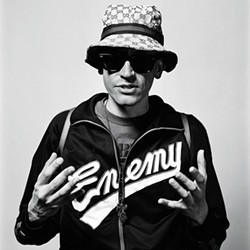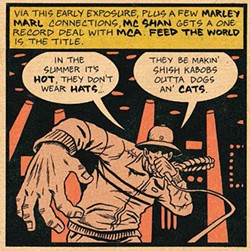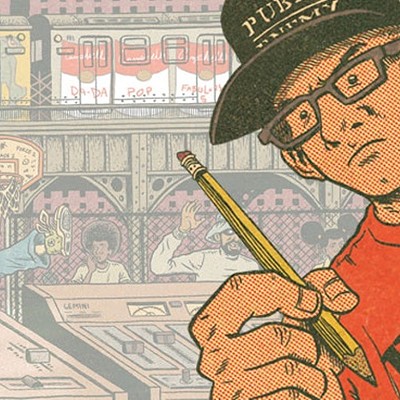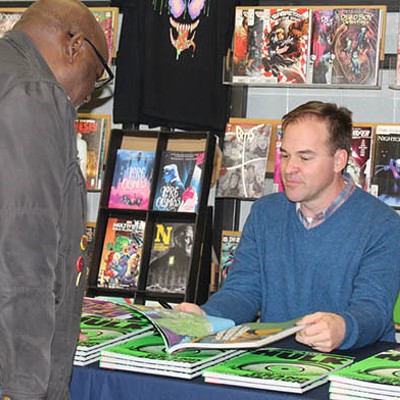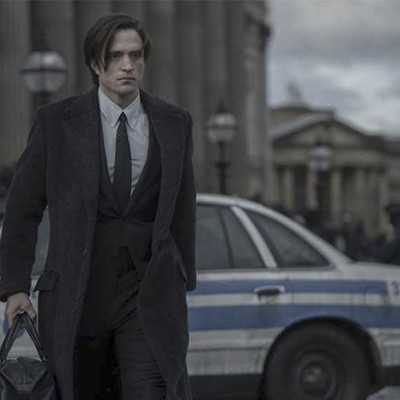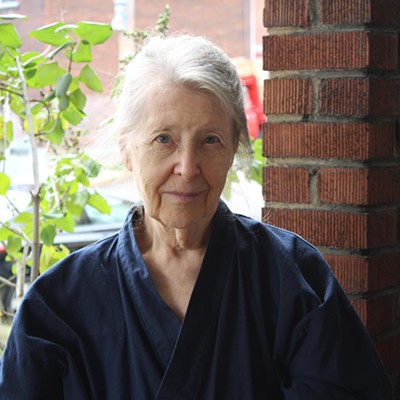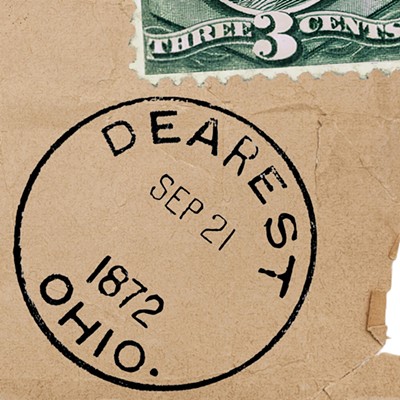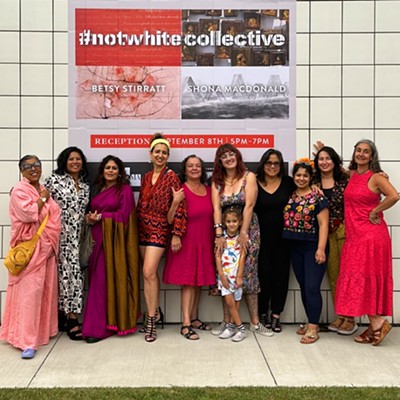Cartoonist Ed Piskor is reaching new heights
Hip Hop Family Tree series catapults Munhall resident to international fame
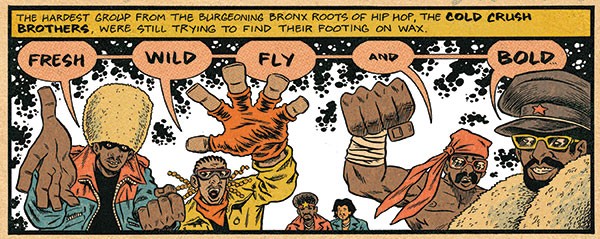
The Cold Crush Brothers, as depicted by Ed Piskor in Hip Hop Family Tree Book 4
On Aug. 3, Fantagraphics published Book 4 of Ed Piskor’s graphic history Hip Hop Family Tree. In comics, where self-publishing is common and most artists never get one full-color volume on a major publisher, four in three years is a very big deal.
Still, those of us outside comics might not grasp how large and in charge Munhall resident Piskor has become with his vibrant, gritty and painstakingly researched portrait of the rise of hip hop, and the many characters who made it happen. The series, which debuted in 2013, has been critically hailed by everyone from Vice and Paste to NPR and Comic Book Resources — not to mention many of the hip-hop artists it depicts. Book 1, a New York Times best-seller, is in its sixth printing. Translations have been licensed in Japanese, German, French, Portuguese, Italian and Russian.
Piskor is huge even for Seattle-based Fantagraphics, a leading independent-comics publisher that’s home to such stars as Chris Ware and Daniel Clowes. “Ed is our biggest breakout star of this decade,” writes Fantagraphics associate publisher Eric Reynolds via email.
The series has changed its creator’s life: While he’s been cartooning full time for years, Piskor says, “The hip-hop comic is popular enough that I’m able to design my career.” (Other bennies: getting to design, for his Japanese publisher, Presspop, new action figures of his all-time favorite group, Public Enemy.)
Accolades for Piskor include last year’s coveted Eisner Award for best reality-based work, for HHFT Book 2. This year, he’s in mad demand as a speaker. In September alone, after an appearance at the Small Press Expo (SPX), in Maryland, he’ll speak at the Library of Congress’ National Book Festival, the country’s largest such fest. SPX executive director Warren Bernard calls HHFT “one of the finest pieces of graphic-novel history that’s ever been done.”
Piskor’s fellow Pittsburgh-based comics artist Frank Santoro goes further. Santoro, also a critic, is internationally known for his comics, but he says that commercially and artistically, Piskor has reached another level entirely. “He’s now the most dominant player in the game [that] I’ve ever seen,” says Santoro. “Ed has just gone above and beyond what has been thought possible.”
Piskor, 34, was born in Munhall, and grew up a working-class kid immersed in comics and ’80s hip-hop culture. After graduating from Steel Valley High School, he spent a year studying cartooning at New Jersey’s Kubert School. But much of his comics education came in Pittsburgh, hanging out at Bill Boichel’s Copacetic Comics and soaking up knowledge from older cartoonists like Santoro, Jim Rugg and Tom Scioli.
In his early 20s, Piskor began making his name with contributions to Harvey Pekar’s fabled American Splendor series (thus joining a pantheon that included Piskor’s biggest influence, R. Crumb). Book-length collaborations with Pekar followed — as did Wizzywig, Piskor’s own graphic novel, about a fictional computer hacker. In 2012, Rolling Stone called Wizzywig “the next big thing in graphic novels.” But by then, Piskor was already rolling on Hip Hop Family Tree, which premiered as a strip on website Boing Boing. The Fantagraphics deal followed; by the time the large-format Book 1 came out, in October 2013, it was already a word-of-mouth sensation. (SPX’s Bernard said HHFT transitioned from web to print better than any comic he can recall.) Rap luminary Biz Markie, for instance, called HHFT “the comic of all time.”
The brand-new Book 4 covers 1984-85 and continues Piskor’s fine-grained take on hip hop’s story. With a cover featuring Salt-N-Pepa, it ranges from obscure figures like Egyptian Lover to the prehistory of NWA and the first house parties of DJ Jazzy Jeff & the Fresh Prince, even while extending the narratives of seminal figures like Russell Simmons, Run-DMC and KRS-One. Piskor also carefully paints the wider cultural backdrop: the crack epidemic, the MOVE disaster in Philadelphia, and mainstream culture’s first nods at hip hop, with movies like Krush Groove. Visually, Piskor summons the aesthetic of classic Marvel Comics (Jack Kirby, et al.), so that the story of rapper Roxanne Shante feels like a superhero tale, complete with colors digitally sampled from vintage comics.
Cartoonist Santoro, also a writer for the online Comics Journal, enthuses that Piskor’s fusion of superhero-comics brio, sophisticated storytelling and culturally relevant subject matter has had an epochal effect. “He basically retooled comics, and he revved it back up,” says Santoro. “Culturally, Ed has just shattered the ceiling. There’s just no one in comics who can approach his reach.”
Even those whose praise is more measured acknowledge Piskor’s potential. “It’s incredibly exciting to watch him blossom artistically,” says John Kelly, vice president of Pittsburgh’s ToonSeum. Copacetic Comics owner Bill Boichel, the godfather of the local comic scene, says Piskor is trying to bridge the gap between superhero fans and aficionados of more literary comics forms: “He wants to synthesize a new audience. Ed’s nothing if not ambitious.”
Asked about the impact of HHFT, Piskor sounds a more modest note. “I sort of found my voice with it. … Now it’s about not taking it for granted.”
There seems little risk of that: Piskor’s work ethic is legendary. “He’s the hardest working guy I’ve ever met in my life,” says Kelly. Indeed, interviewed by phone in early August, Piskor — who also travels overseas to teach cartooning in Denmark — says, “I’ve basically been working into exhaustion regularly.”
He’s not, however, toiling on the next volume of HHFT. “I’m not even thinking about it right now,” he says. Rather, he’s got a big new project, not yet publicly announced, that he’s pretty excited about.
“I think Hip Hop Family Tree is probably going to be my life’s work,” Piskor acknowledges, but adds, “It was four and a half years working on that. I need to catch my breath.”
Still, those of us outside comics might not grasp how large and in charge Munhall resident Piskor has become with his vibrant, gritty and painstakingly researched portrait of the rise of hip hop, and the many characters who made it happen. The series, which debuted in 2013, has been critically hailed by everyone from Vice and Paste to NPR and Comic Book Resources — not to mention many of the hip-hop artists it depicts. Book 1, a New York Times best-seller, is in its sixth printing. Translations have been licensed in Japanese, German, French, Portuguese, Italian and Russian.
Piskor is huge even for Seattle-based Fantagraphics, a leading independent-comics publisher that’s home to such stars as Chris Ware and Daniel Clowes. “Ed is our biggest breakout star of this decade,” writes Fantagraphics associate publisher Eric Reynolds via email.
The series has changed its creator’s life: While he’s been cartooning full time for years, Piskor says, “The hip-hop comic is popular enough that I’m able to design my career.” (Other bennies: getting to design, for his Japanese publisher, Presspop, new action figures of his all-time favorite group, Public Enemy.)
Accolades for Piskor include last year’s coveted Eisner Award for best reality-based work, for HHFT Book 2. This year, he’s in mad demand as a speaker. In September alone, after an appearance at the Small Press Expo (SPX), in Maryland, he’ll speak at the Library of Congress’ National Book Festival, the country’s largest such fest. SPX executive director Warren Bernard calls HHFT “one of the finest pieces of graphic-novel history that’s ever been done.”
Piskor’s fellow Pittsburgh-based comics artist Frank Santoro goes further. Santoro, also a critic, is internationally known for his comics, but he says that commercially and artistically, Piskor has reached another level entirely. “He’s now the most dominant player in the game [that] I’ve ever seen,” says Santoro. “Ed has just gone above and beyond what has been thought possible.”
Piskor, 34, was born in Munhall, and grew up a working-class kid immersed in comics and ’80s hip-hop culture. After graduating from Steel Valley High School, he spent a year studying cartooning at New Jersey’s Kubert School. But much of his comics education came in Pittsburgh, hanging out at Bill Boichel’s Copacetic Comics and soaking up knowledge from older cartoonists like Santoro, Jim Rugg and Tom Scioli.
In his early 20s, Piskor began making his name with contributions to Harvey Pekar’s fabled American Splendor series (thus joining a pantheon that included Piskor’s biggest influence, R. Crumb). Book-length collaborations with Pekar followed — as did Wizzywig, Piskor’s own graphic novel, about a fictional computer hacker. In 2012, Rolling Stone called Wizzywig “the next big thing in graphic novels.” But by then, Piskor was already rolling on Hip Hop Family Tree, which premiered as a strip on website Boing Boing. The Fantagraphics deal followed; by the time the large-format Book 1 came out, in October 2013, it was already a word-of-mouth sensation. (SPX’s Bernard said HHFT transitioned from web to print better than any comic he can recall.) Rap luminary Biz Markie, for instance, called HHFT “the comic of all time.”
The brand-new Book 4 covers 1984-85 and continues Piskor’s fine-grained take on hip hop’s story. With a cover featuring Salt-N-Pepa, it ranges from obscure figures like Egyptian Lover to the prehistory of NWA and the first house parties of DJ Jazzy Jeff & the Fresh Prince, even while extending the narratives of seminal figures like Russell Simmons, Run-DMC and KRS-One. Piskor also carefully paints the wider cultural backdrop: the crack epidemic, the MOVE disaster in Philadelphia, and mainstream culture’s first nods at hip hop, with movies like Krush Groove. Visually, Piskor summons the aesthetic of classic Marvel Comics (Jack Kirby, et al.), so that the story of rapper Roxanne Shante feels like a superhero tale, complete with colors digitally sampled from vintage comics.
Cartoonist Santoro, also a writer for the online Comics Journal, enthuses that Piskor’s fusion of superhero-comics brio, sophisticated storytelling and culturally relevant subject matter has had an epochal effect. “He basically retooled comics, and he revved it back up,” says Santoro. “Culturally, Ed has just shattered the ceiling. There’s just no one in comics who can approach his reach.”
Even those whose praise is more measured acknowledge Piskor’s potential. “It’s incredibly exciting to watch him blossom artistically,” says John Kelly, vice president of Pittsburgh’s ToonSeum. Copacetic Comics owner Bill Boichel, the godfather of the local comic scene, says Piskor is trying to bridge the gap between superhero fans and aficionados of more literary comics forms: “He wants to synthesize a new audience. Ed’s nothing if not ambitious.”
Asked about the impact of HHFT, Piskor sounds a more modest note. “I sort of found my voice with it. … Now it’s about not taking it for granted.”
There seems little risk of that: Piskor’s work ethic is legendary. “He’s the hardest working guy I’ve ever met in my life,” says Kelly. Indeed, interviewed by phone in early August, Piskor — who also travels overseas to teach cartooning in Denmark — says, “I’ve basically been working into exhaustion regularly.”
He’s not, however, toiling on the next volume of HHFT. “I’m not even thinking about it right now,” he says. Rather, he’s got a big new project, not yet publicly announced, that he’s pretty excited about.
“I think Hip Hop Family Tree is probably going to be my life’s work,” Piskor acknowledges, but adds, “It was four and a half years working on that. I need to catch my breath.”

